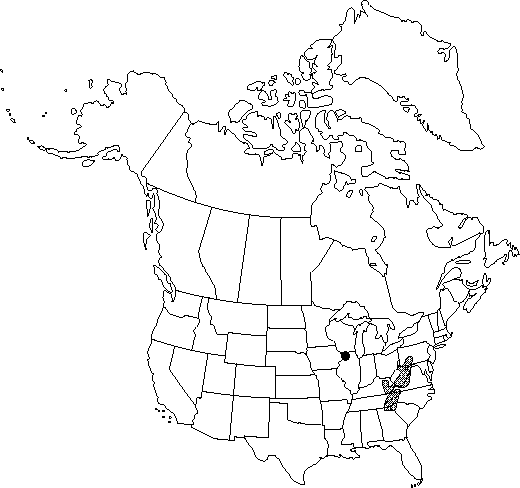Difference between revisions of "Cimicifuga americana"
Fl. Bor.-Amer. 1: 316. 1803.
FNA>Volume Importer |
imported>Volume Importer |
||
| (5 intermediate revisions by 2 users not shown) | |||
| Line 13: | Line 13: | ||
}}{{Treatment/ID/Special_status | }}{{Treatment/ID/Special_status | ||
|code=F | |code=F | ||
| − | |label= | + | |label=Illustrated |
}} | }} | ||
|basionyms= | |basionyms= | ||
| Line 19: | Line 19: | ||
|name=Cimicifuga cordifolia | |name=Cimicifuga cordifolia | ||
|authority=Pursh | |authority=Pursh | ||
| + | |rank=species | ||
}} {{Treatment/ID/Synonym | }} {{Treatment/ID/Synonym | ||
|name=Cimicifuga racemosa var. cordifolia | |name=Cimicifuga racemosa var. cordifolia | ||
|authority=(Pursh) A. Gray | |authority=(Pursh) A. Gray | ||
| + | |rank=variety | ||
}} | }} | ||
|hierarchy=Ranunculaceae;Cimicifuga;Cimicifuga americana | |hierarchy=Ranunculaceae;Cimicifuga;Cimicifuga americana | ||
| Line 46: | Line 48: | ||
-->{{#Taxon: | -->{{#Taxon: | ||
name=Cimicifuga americana | name=Cimicifuga americana | ||
| − | |||
|authority=Michaux | |authority=Michaux | ||
|rank=species | |rank=species | ||
| Line 60: | Line 61: | ||
|publication title=Fl. Bor.-Amer. | |publication title=Fl. Bor.-Amer. | ||
|publication year=1803 | |publication year=1803 | ||
| − | |special status=Endemic; | + | |special status=Endemic;Illustrated |
| − | |source xml=https:// | + | |source xml=https://bitbucket.org/aafc-mbb/fna-data-curation/src/2e0870ddd59836b60bcf96646a41e87ea5a5943a/coarse_grained_fna_xml/V3/V3_1126.xml |
|genus=Cimicifuga | |genus=Cimicifuga | ||
|species=Cimicifuga americana | |species=Cimicifuga americana | ||
Latest revision as of 21:46, 5 November 2020
Stems 60-250 cm, usually glabrous, rarely sparsely pubescent. Leaves: petiole rounded abaxially, 8-16 cm, broadly and shallowly grooved adaxially, glabrous, rarely with a few lax hairs in groove. Leaf blade (2-)3-ternately compound; leaflets 32-100; terminal leaflet of central segment ovate to oblong, incisely 3-lobed, 6-15 × 4-14 cm, with 3 veins arising basally, base cuneate to somewhat cordate, margins dentate to serrate, apex acute to acuminate, surfaces glabrous or glabrate; other leaflets 3-15 × 3-10 cm. Inflorescences ± lax panicles of 3-10 racemelike branches, 10-50 cm, densely short-pubescent and granular; bract 1, subtending pedicel, broadly triangular, acute, 1-3 mm; pedicel to 20 mm, granular, bracteoles present along most of pedicel, narrowly triangular, acute. Flowers: sepals 5, 3 outer white tinged red, 2 inner yellowish green; petals usually 2, rarely more, sessile, body yellowish with white lobes, ovate, 3-6 mm; nectary basal; stamens 40-70; filaments 6-10 mm; pistils 3-8, short-stipitate, body glabrous, stipe granular; style subulate, often curved; stigma minute, 0.2 mm wide. Follicles 2-4, stipitate, obovate, laterally compressed, 8-17 mm, membranous walled, glabrous. Seeds pale brown, lenticular, ca. 3.5 mm, covered with whitish, broad, lacerate scales but not apprearing cylindric.
Phenology: Flowering summer–fall (Aug–Oct).
Habitat: Moist, rich, rocky and boulder-strewn, wooded slopes and coves
Elevation: 300-2000 m
Distribution

Ga., Ill., Ky., Md., N.C., Pa., S.C., Tenn., Va., W.Va.
Discussion
Much confusion has developed over the name Cimicifuga cordifolia Pursh. Although F. Pursh (1814, vol. 2, pp. 372-373) considered it synonymous with C. americana, several other authors have variously misapplied the name C. cordifolia to C. racemosa and C. rubifolia.
Selected References
None.
